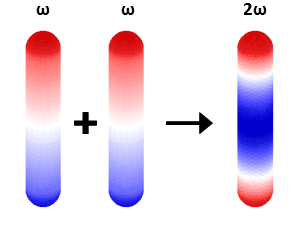
Second Harmonic Generation Reveals Dark Modes in Plasmonics Nanostructures
In the dipolar approximation, second harmonic generation (SHG) is forbidden in the bulk of centrosymmetric nanostructures (such as gold) but can arise at the interface thanks to the breaking of the inversion symmetry. As a consequence, SHG is an appropriate tool to acquire information about nanostructures surfaces. In this presentation, we will show that SHG can also provide information on the underlying modes supported by the structure. Furthermore, a combination of modes at the fundamental frequency can generate SH waves supported by modes that cannot be excited at the fundamental frequency, the so called dark modes, Fig. 1. This optical nonlinear process can then be used to measure the radiation pattern of those dark modes. If the fundamental frequency matches a resonance of the structure, the high field enhancement will yield a high SHG. Additionally, if the SH frequency matches another higher frequency mode, the SH emission will be stronger and thus more easily measurable. Being able to optimize the structure so that both SHG and fundamental frequencies match resonant modes is then very useful for practical applications.

Figure 1: combination of two dipolar modes to generate a quadrupolar mode at the second harmonic for a plasmonic nanorod in water of length L=100 nm and radius R=10 nm. The resonant wavelengths are respectively at 992 nm and 646 nm.
It will be further shown how resonant modes can be computed from a surface integral equation formulation by studying the eigenfunctions of the corresponding matrix, and how these modes are coupled at the fundamental frequency to give the SH wave. The versatility of our approach will be illustrated with several geometries and coupled plasmonics nanosystems. These results pave the way for the design of efficient plasmonic SHG sources.
Gabriel D. Bernasconi*, Jeremy Butet, and Olivier J.F. Martin
gabriel.bernasconi@epfl.ch
Powered by Eventact EMS